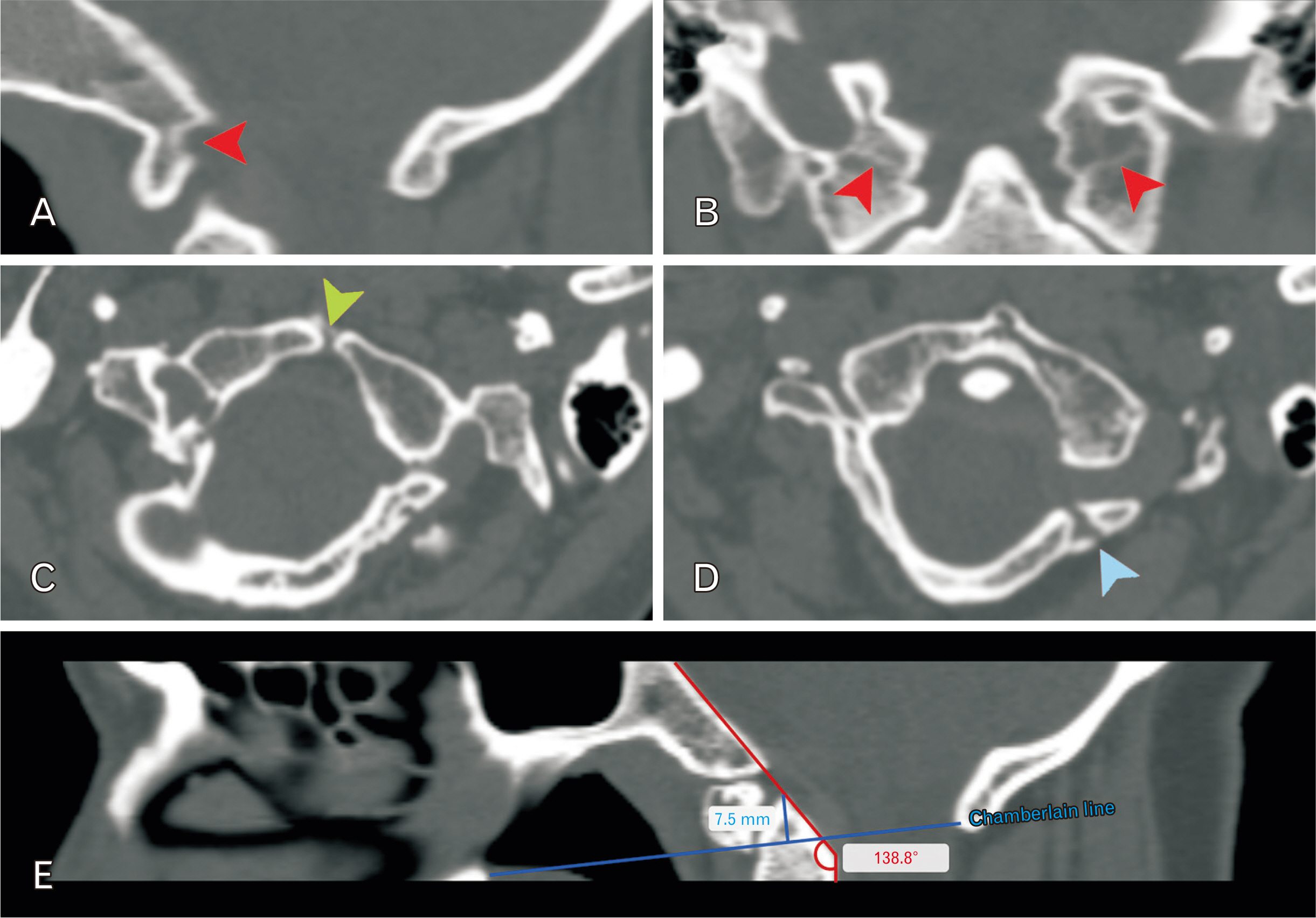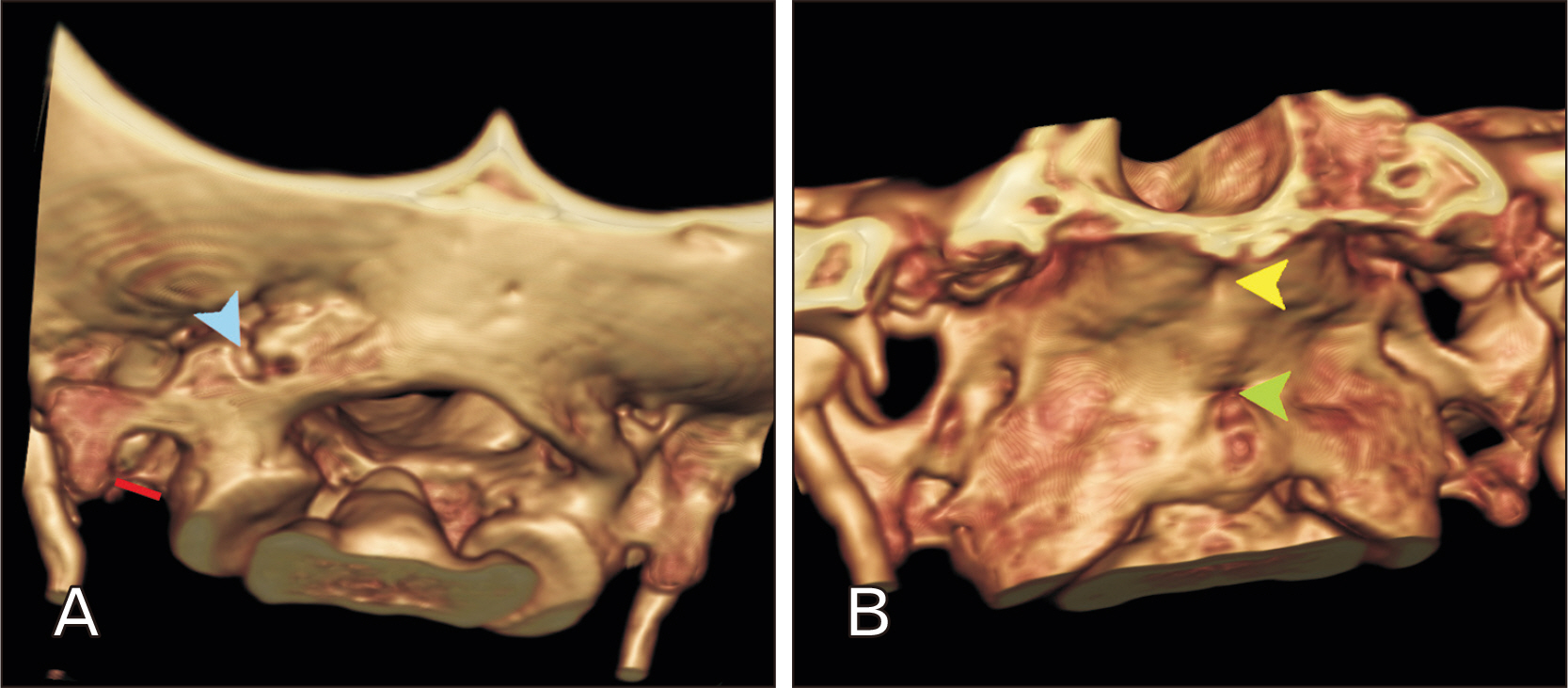Anat Cell Biol.
2024 Sep;57(3):468-472. 10.5115/acb.23.281.
Atlantooccipital assimilation associated with combined atlas arch defect: a radiological case report
- Affiliations
-
- 1Department of Anatomy, Faculty of Science, Mahidol University, Bangkok, Thailand
- 2In Silico and Clinical Anatomy Research Group (iSCAN), Bangkok, Thailand
- 3Department of Radiology, Faculty of Medicine, Khon Kaen University, Khon Kaen, Thailand
- 4Department of Anatomy, Faculty of Medicine, Kasetsart University, Bangkok, Thailand
- 5Electron Microscopy Unit, Department of Anatomy, Faculty of Medicine, Khon Kaen University, Khon Kaen, Thailand
- KMID: 2559768
- DOI: http://doi.org/10.5115/acb.23.281
Abstract
- In this report, atlantooccipital assimilation (AS), anterior arch defect (AAD), and posterior arch defect (PAD) of the atlas, and several variations around the craniocervical junction were identified on computed tomography (CT) of a patient of unknown sex and age. Coronal and sagittal CT scans showed AS and bilateral fusion of the atlas and the base of occipital bone. Axial CT scan at the atlas revealed PAD type B on the left side and midline AAD. Morphometric measurements indicated a potential ventral spinal cord compression. In addition, mid-sagittal CT revealed the presence of fossa navicularis magna and incomplete formation of the transverse foramen on the right side. This study reports an extremely rare AS associated with AAD, PAD, and other variations of the clivus and the atlas. To our knowledge, no similar case has been reported in the literature.
Figure
Reference
-
References
1. Suphamungmee W, Yurasakpong L, Poonudom K, Tubbs RS, Iwanaga J, Kruepunga N, Chaiyamoon A, Suwannakhan A. 2023; Radiological study of atlas arch defects with meta-analysis and a proposed new classification. Asian Spine J. 17:975–84. DOI: 10.31616/asj.2023.0030. PMID: 37634902. PMCID: PMC10622819.2. Park Y, Kim SM, Lee YT, Yoo JH, Oh HC, Ha JW, Sung SY, Yoon HK, Chang JH, Jung JY. 2014; Congenital anomaly of the atlas misdiagnosed as posterior arch fracture of the atlas and atlantoaxial subluxation. Clin Orthop Surg. 6:96–100. DOI: 10.4055/cios.2014.6.1.96. PMID: 24605195. PMCID: PMC3942609.3. Mahajan S, Talwar D, Kumar S, Acharya S, Iratwar S, Annadatha A. 2021; Atlantooccipital assimilation and basilar invagination treated successfully in a young male with marfanoid features: a stitch in time. Cureus. 13:e19365. DOI: 10.7759/cureus.19365. PMID: 34909321. PMCID: PMC8653923.4. Kazanci B, Kahveci R, Ekici MA, Guclu B. 2013; Isolated fracture of anterior arch of atlas in a child: case report and review of the literature. Injury. 44:1956–8. DOI: 10.1016/j.injury.2013.08.004. PMID: 24041431.5. Shah S, Dalvie S, Rai RR. 2017; Congenital malformed posterior arch of atlas with fusion defect: a case of developmental canal stenosis causing cervical myelopathy. J Spine Surg. 3:489–97. DOI: 10.21037/jss.2017.08.04. PMID: 29057363. PMCID: PMC5637200.6. Chilamkurthy S, Ghosh R, Tanamala S, Biviji M, Campeau NG, Venugopal VK, Mahajan V, Rao P, Warier P. 2018; Deep learning algorithms for detection of critical findings in head CT scans: a retrospective study. Lancet. 392:2388–96. DOI: 10.1016/S0140-6736(18)31645-3. PMID: 30318264.7. Sharma A, Gaikwad SB, Deol PS, Mishra NK, Kale SS. 2000; Partial aplasia of the posterior arch of the atlas with an isolated posterior arch remnant: findings in three cases. AJNR Am J Neuroradiol. 21:1167–71. PMID: 10871035. PMCID: PMC7973897.8. Al-Motabagani MA, Surendra M. 2006; Total occipitalization of the atlas. Anat Sci Int. 81:173–80. DOI: 10.1111/j.1447-073X.2006.00129.x. PMID: 16955668.9. Karwacki GM, Schneider JF. 2012; Normal ossification patterns of atlas and axis: a CT study. AJNR Am J Neuroradiol. 33:1882–7. DOI: 10.3174/ajnr.A3105. PMID: 22576894. PMCID: PMC7964599.10. Currarino G, Rollins N, Diehl JT. 1994; Congenital defects of the posterior arch of the atlas: a report of seven cases including an affected mother and son. AJNR Am J Neuroradiol. 15:249–54. PMID: 8192068. PMCID: PMC8334620.11. Smoker WR, Khanna G. 2008; Imaging the craniocervical junction. Childs Nerv Syst. 24:1123–45. DOI: 10.1007/s00381-008-0601-0. PMID: 18461336.12. Yoon K, Cha SW, Ryu JA, Park DW, Lee S, Joo KB. 2015; Anterior atlantodental and posterior atlantodental intervals on plain radiography, multidetector CT, and MRI. J Korean Soc Radiol. 72:57–64. DOI: 10.3348/jksr.2015.72.1.57.13. Settle SH Jr, Rountree RB, Sinha A, Thacker A, Higgins K, Kingsley DM. 2003; Multiple joint and skeletal patterning defects caused by single and double mutations in the mouse Gdf6 and Gdf5 genes. Dev Biol. 254:116–30. DOI: 10.1016/S0012-1606(02)00022-2. PMID: 12606286.14. Tassabehji M, Fang ZM, Hilton EN, McGaughran J, Zhao Z, de Bock CE, Howard E, Malass M, Donnai D, Diwan A, Manson FD, Murrell D, Clarke RA. 2008; Mutations in GDF6 are associated with vertebral segmentation defects in Klippel-Feil syndrome. Hum Mutat. 29:1017–27. DOI: 10.1002/humu.20741. PMID: 18425797.15. Bayrak S, Göller Bulut D, Orhan K. 2019; Prevalence of anatomical variants in the clivus: fossa navicularis magna, canalis basilaris medianus, and craniopharyngeal canal. Surg Radiol Anat. 41:477–83. DOI: 10.1007/s00276-019-02200-3. PMID: 30725217.16. Aziz J, Morgan M. 2018; Morphological study of the foramen transversarium of the atlas vertebra among Egyptian population and its clinical significance. Anat Physiol Biochem Int J. 4:555642. DOI: 10.19080/APBIJ.2018.04.555642.
- Full Text Links
- Actions
-
Cited
- CITED
-
- Close
- Share
- Similar articles
-
- Anatomical Variant of Atlas : Arcuate Foramen, Occpitalization of Atlas, and Defect of Posterior Arch of Atlas
- Congenital Anomaly of the Atlas Misdiagnosed as Posterior Arch Fracture of the Atlas and Atlantoaxial Subluxation
- Cervical Myelopathy Secondary to Atlanto-occipital Assimilation: The Usefulness of the Simple Decompressive Surgery
- Atlanto-occipital assimilation: embryological basis and its clinical significance
- Congenital Hypoplasia of the Posterior Arch of the Atlas Associated with a Fracture of the Odontoid Process: A Case Report



